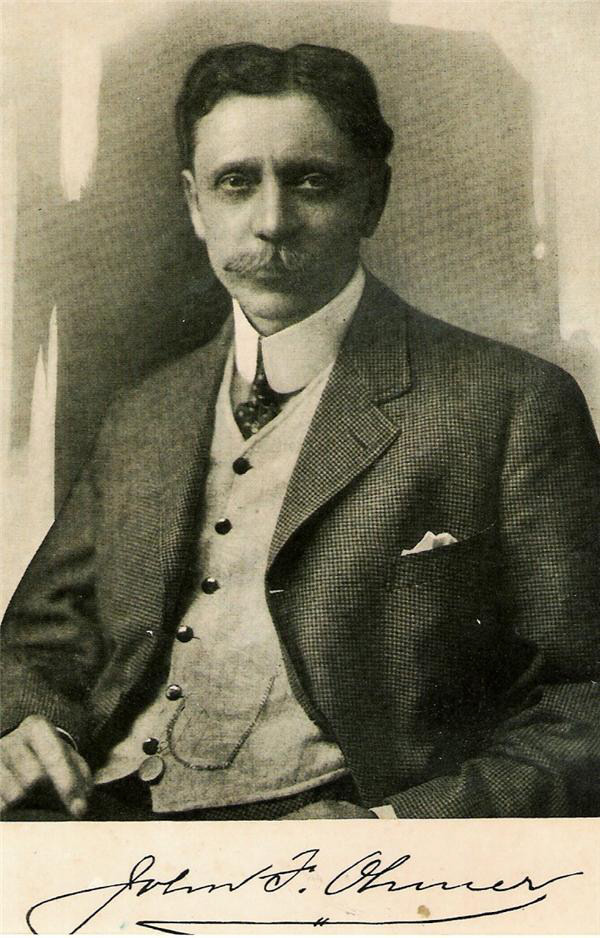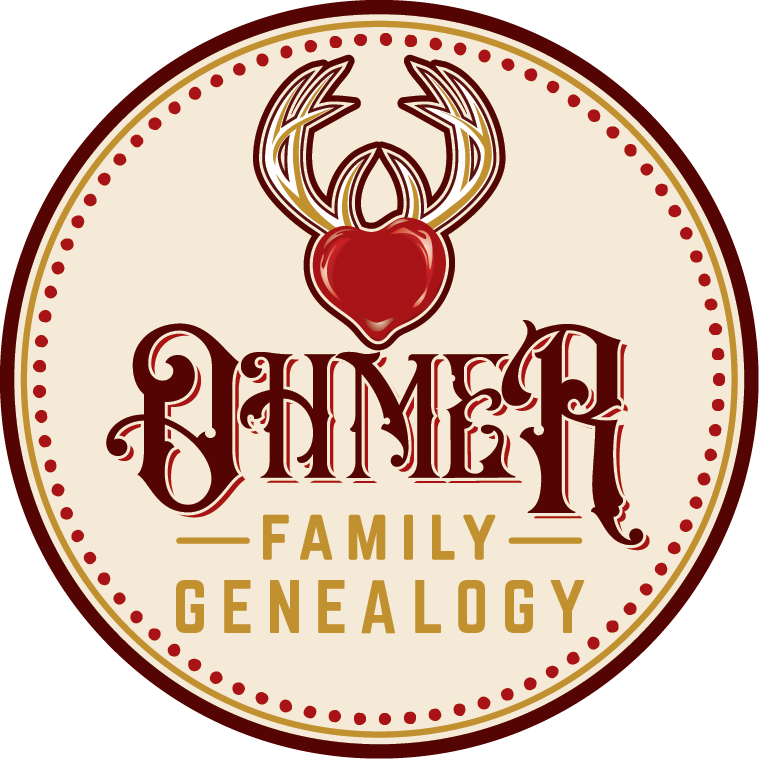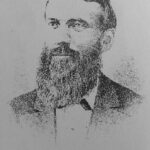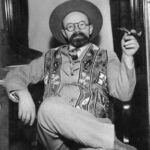

November 7, 1856 – November 4, 1938
OHMER, John Francis, manufacturer and inventor, was born in Dayton, Ohio, Nov. 7, 1856, son of Michael and Rose Marie (Welty) Ohmer. His father, a native of Alsace, France, came to America in 1831 and settled the following year in Dayton, where he was a furniture manufacturer and a pioneer promoter of street car railways. The son attended St. Mary’s College (later the University of Dayton). At the age of fourteen he became an apprentice in his father’s furniture factory and four years later obtained his first patent on a furniture caster. Following the retirement of his father in 1878 he purchased the furniture business and, after admitting his brothers into the firm, reorganized it as the M. Ohmer Sons Co., of which he was president until the company was dissolved in 1927.
In addition to manufacturing household furniture the company did an extensive business in bank and office interiors. It manufactured most of the wooden filing cabinets used by railroads for holding tickets in the ticket offices. Other types of wooden filing cabinets were manufactured for general office use. Ohmer traveled extensively in the interests of his company and in 1881, realizing the opportunities in the Northwest, he obtained from James J. Hill (q.v.) a franchise to operate dining stations and restaurants on the St. Paul & Manitoba railroad, later a part of the Northern Pacific system. While still a boy he had observed the need of some device for keeping an accurate tally of the fares collected on street cars and railroad trains, and his continued association with the transportation industry confirmed his belief that the existing fare collection methods were inadequate.
He began a series of experiments which in 1898 culminated in his perfecting the Ohmer indicating and recording fare register (patent no. 560529 – 1896); 597560 and 597561 – 1898). Like the later cash register, this register publicly indicated the amount received, registered and made a permanent printed record of it, thus furnishing the basis for a proper accounting system to be used by transportation companies. Interesting a number of Rochester, N.Y., businessmen in his patent, Ohmer secured sufficient capital to start manufacturing his register on a small scale in Dayton with the assistance of four employees. Organized in November 1898 as the Ohmer Car Register Co., with Ohmer as vice president and general manager, it was incorporated in 1902 as the Ohmer Fare Register Co., with a capital of $1,500,000. He became president of the company in 1905. His pioneer register played such an important part in providing full protection over railway income and maintaining the operation on a sound economic basis that it came to be considered an indispensable aid in the operation of a transportation system and its use became general throughout the United States.
Keeping pace with the development of extensive motor bus operations, other Ohmer transportation registers were devised and the line eventually comprised not only a large range of multiple recording and indicating fare registers, but a complete line of ticket printing and issuing machines and several types of fare boxes. The early success of the Ohmer company in the marketing of registers for the use of the electric railway industry led their inventor to apply some of the same mechanical principles to the invention of a printing taximeter for the use of the taxicab industry. The Ohmer Printing Taximeter (patent no. 1136164, 1915) was the first patent ever issued on a ticket-issuing taximeter. The Ohmer taximeter printed all the fare and facts concerning the transaction on a detail record and on the receipt given to the passenger. It was manufactured by the Ohmer Fare Register Co. in Dayton and the first taximeters were installed in 1915 by the Quaker City Cab Co. in Philadelphia.
When the United States entered the First World War, Ohmer offered the facilities of his plant for the manufacture of gun sights and mounts, which necessitated the acquisition of much heavy equipment, and after the war the Edgemont plant in Dayton was used for the manufacture of boring mills, automatic screw machines and other machinery. In 1919, however, the plant was again altered to concentrate on the manufacture of registers and taximeters. In 1924, the Ohmer Fare Register Co. acquired the American Taximeter Co., whose New York plant and office became its first factory branch. Other branches were established in Boston, Chicago, Cleveland, Detroit, Los Angeles, Philadelphia, Portland, Oregon, and San Francisco. The taximeter development was followed by the perfection of a line of distance, speed and time recording instruments for charting the performance of motor vehicles and the output of industrial machinery. These included the Ohmer Hubodometer, which recorded the miles from the hub-cap of trucks; the Ohmer Recordograph, which plotted a line chart showing the stops and starts, speed traveled and number of miles traveled by a vehicle; the Atco Taximeter, a non-printing taximeter used by individual taxicab operators, and the Ohmer odometer, a mileage recording instrument for heavy-duty purposes.
In 1928 the company began to market the Ohmer cash register based on many of Ohmer’s patented inventions. Many improvements and adaptations were gradually made to the original Ohmer cash register until a number of different styles and types were manufactured containing many unique and exclusive patented features never before incorporated in cash register construction or functions. In 1931 the Ohmer-Kienzle vibracorder and the Ohmer-Kienzle tachograf, for the recording of performances of motor vehicles and machinery, were introduced. A later addition was the Ohmer tool control register, for the control of tools in factories, which was adopted by the U.S. army air force as standard at all army air bases. In 1928 the Canadian Ohmer Co., Ltd., with offices in Montreal, was formed for handling the distribution of Ohmer products in Canada and in 1931 the Ohmer Register Co. was incorporated under the laws of Ohio to act as sales agent for the parent company.
Until his death John F. Ohmer was the company’s chief inventor, and he obtained 112 basic patents in his own name and as co-inventor. In the great majority of these he was the sole inventor. The remarkable development of the company from a small business to a great organization with a world-wide market was directly due to his perseverance in the face of obstacles, his inventive genius, his high administrative ability and his intimate knowledge of sales problems, gained through his own personal experience. One of the foremost citizens of Dayton, he served for many years on the City Planning Board and was a charter member of the Dayton Rotary Club. He also belonged to the Dayton City, Dayton Country and Dayton Engineers’ Clubs. In religion he was a Roman Catholic and in politics a Republican. When he could spare the time, he did some hunting and fishing on his 1200-acre farm in Maryland, which was one of his greatest recreations. Ohmer was married in Cleveland, Sept. 29, 1886, to Anna Katharine, daughter of Henry Beckman of that city, a clothing manufacturer. They had seven children: Louise Rose, who married Robert Louis Hubler; Henry Beckman; John Francis; Frederick Louis; Raymund Michael; Anita Marie who married Victor R. Coudert, and Katherine Angela Ohmer, who married George Wilson Shaw John F. Ohmer died in Dayton, Nov. 4, 1938.



 |
| 


Leave a reply